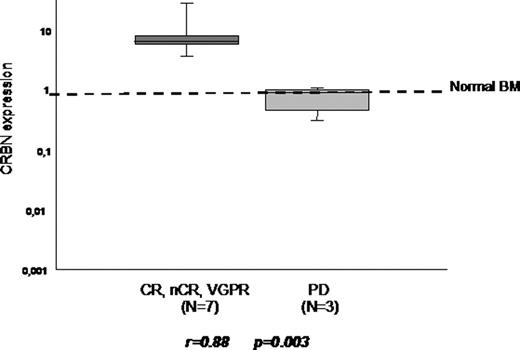Abstract
Abstract 2879
Immunomodulatory drugs (IMiDs) are highly active in the treatment of multiple myeloma (MM), but the mechanisms of action are still not completely understood. Recently, cereblon (CRBN) has been identified as the primary target of thalidomide teratogenicity (Ito K et al, 2010) and, moreover as an essential requirement for IMiD therapy (Zhu YX et al, 2011). We wanted to investigate, if expression levels of CRBN could serve as a predictor of response.
We measured CRBN mRNA expression in bone marrow samples of 44 well characterized MM patients treated with lenalidomide containing regimens, myeloma cell lines, and normal bone marrow (BM), using real time PCR. The median age of patients was 65 years (range: 37–85 years). Nine patients had ISS-stage I, 9 stage II, and 26 had stage III. All patients, except 12, were newly diagnosed. None of the patients had been exposed to lenalidomide before study entry. Full data documentation for response evaluation (> 2 cycles) was available in 37 patients (84%). Of these, lenalidomide was given in combination with dexamethasone in 27 patients with a starting dose of 25 mg per day on days 1–21 in a 28 days cycle, in combination with melphalan and prednisone (MPR, starting dose of lenalidomide 10 mg per day on days 1–21) in 9 patients, and in combination with bendamustine in 1 patient.
Normal BM was used as a reference with an expression level of one. All multiple myeloma cell lines tested (U266, KMS-12-BM, OPM-2, NCL-H929, MM.1S, SK-MM-1, and RPMI8226), had a higher CRBN expression than normal BM. CRBN was detected in all 44 MM samples distributed over a range covering 3 orders of magnitude (0.31 to 462.08-fold relative to normal BM; median: 3.61).
Lenalidomide-based therapy resulted in CR in 3 (8%), nCR in 2 (5%), VGPR in 4 (11%), PR in 17 (46%), and in MR in 4 patients (11%), respectively. Three patients (8%) had SD, and 4 (11%) had PD. Median CRBN expression was three times higher in responding (≥MR) patients compared to non-responders (3.65 vs. 0.99, p<0.01). In addition, a significant correlation between quality of response and CRBN expression (r=0.34) was observed. This correlation remained statistically significant after exclusion of previously treated patients (r=0.37, p=0.02). Interestingly, among 9 available patients who had been pretreated, the lowest level of CRBN expression (0.90) was noted in the patient who progressed during lenalidomide treatment, indicating a predictive potential of CRBN expression also in pre-treated patients.
When the analysis was restricted to the 27 patients who had uniformly been treated with lenalidomide and dexamethasone, an even more pronounced association between myeloma response and CRBN expression was noted (r=0.45; p=0.008). In patients with SD or PD, median CRBN expression was lower than in normal BM, while a higher CRBN expression was found in all patients with CR, nCR, VGPR, PR or MR (Table 1), suggesting that CRBN was required for anti-myeloma activity in these patients. This applied also to patients with marked myeloma response (CR, nCR, VGPR) and patients with PD (r=0.82; p= 0.003) (Figure 1).
Univariate analysis between established prognostic factors such as beta-2-microglobulin, albumin, ISS stage, Hb, FISH defined cytogenetic aberrations, and response revealed no significant correlation in this patient cohort. A highly significant correlation between expression of CRBN and IRF4, an important transcription factor required for myeloma survival (p=0.00007), and XBP1 (p=0.00004) was observed. For PAX5 and BLIMP no such association were noted. When primary myeloma cells of 5 patients and cell lines (U 266, KMS-12-M) were exposed to lenalidomide, a significant down regulation of IRF4, but not of CRBN was found.
Our studies show a significant association between CRBN expression and myeloma response in patients treated with lenalidomide containing regimens, especially in those receiving lenalidomide and dexamethasone therapy. These findings should be confirmed in larger, prospective clinical trials.
| Response quality . | N . | Median CRBN expression . | range . |
|---|---|---|---|
| CR | 3 | 7.26 | 5.88–9.89 |
| nCR | 2 | 4.82 | 3.74–5.89 |
| VGPR | 2 | 18.47 | 8.20–28.74 |
| PR | 13 | 3.02 | 1.15–6.70 |
| MR | 3 | 6.74 | 3.65–462.08 |
| SD | 1 | 0.74 | – |
| PD | 3 | 0.90 | 0.30–1.087 |
| Response quality . | N . | Median CRBN expression . | range . |
|---|---|---|---|
| CR | 3 | 7.26 | 5.88–9.89 |
| nCR | 2 | 4.82 | 3.74–5.89 |
| VGPR | 2 | 18.47 | 8.20–28.74 |
| PR | 13 | 3.02 | 1.15–6.70 |
| MR | 3 | 6.74 | 3.65–462.08 |
| SD | 1 | 0.74 | – |
| PD | 3 | 0.90 | 0.30–1.087 |
Jäger:Roche: Honoraria, Membership on an entity's Board of Directors or advisory committees, Research Funding; Mundipharma: Honoraria, Membership on an entity's Board of Directors or advisory committees; AMGEN: Honoraria, Membership on an entity's Board of Directors or advisory committees; Novartis: Honoraria, Research Funding; Celgene: Honoraria, Membership on an entity's Board of Directors or advisory committees, Research Funding; Biogen: Research Funding.
Author notes
Asterisk with author names denotes non-ASH members.


This feature is available to Subscribers Only
Sign In or Create an Account Close Modal